
Dru Drury was a British collector of natural history specimens and an entomologist. He had specimens collected from across the world through a network of ship's officers and collectors including Henry Smeathman. His collections were utilized by many entomologists of his time to describe and name new species and is best known for his book Illustrations of natural history which includes the names and descriptions of many insects, published in parts from 1770 to 1782 with copperplate engravings by Moses Harris.

Curoba is a monotypic moth genus in the subfamily Arctiinae erected by Francis Walker in 1865. It contains the single species Curoba sangarida, first described by Caspar Stoll in 1782, which is found in southern India and Sri Lanka.
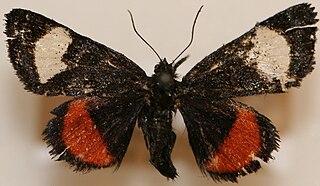
Psychomorpha is a monotypic moth genus of the family Noctuidae erected by Thaddeus William Harris in 1839. Its only species, Psychomorpha epimenis, the grapevine epimenis, was first described by Dru Drury in 1782. It is found in eastern North America as far west as the Oklahoma Panhandle.
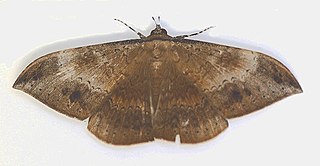
Hemeroblemma opigena is a species of moth in the family Erebidae first described by Dru Drury in 1773. The species is found from Florida to Brazil.

Dismorphia crisia, the crisia mimic white or cloud forest mimic-white, is a butterfly in the family Pieridae. The species was first described by Dru Drury in 1782. It is found from northern Central America to Bolivia and the Amazon basin.

Brachyglene caenea is a moth of the family Notodontidae first described by Dru Drury in 1782. It is restricted to south-eastern Brazil, from Rio de Janeiro south to Santa Catarina.

Hyalurga vinosa is a moth of the family Erebidae first described by Dru Drury in 1773. It is found on Saint Kitts, Antigua, Jamaica and the Dominican Republic.
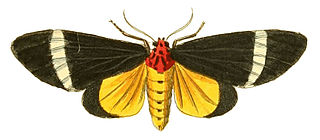
Caryatis phileta is a moth of the subfamily Arctiinae. It was described by Dru Drury in 1782. It is found in Cameroon, the Democratic Republic of the Congo, Gabon, Ghana, Nigeria and Sierra Leone.

Calodesma collaris is a moth of the family Erebidae. It was described by Dru Drury in 1782. It is found in Brazil, Paraguay, Argentina and Bolivia.

Eudesmia menea, the lunar eudesmia, is a moth of the subfamily Arctiinae. It was described by Drury in 1782. It is found from Brazil and Colombia, through Central America, to the southern United States, where it is found from southern Texas to Florida.

Colla rhodope is a moth in the family Bombycidae. It was described by Dru Drury in 1782. It is found from Mexico to Colombia, Ecuador and Brazil.

Crameria is a monotypic moth genus in the family Noctuidae erected by Jacob Hübner in 1819. Its only species, Crameria amabilis, was first described by Dru Drury in 1773.

Tifama is a monotypic moth genus in the family Notodontidae erected by Francis Walker in 1855. Its only species, Tifama chera, was first described by Dru Drury in 1773. The species is known from Suriname and Brazil.

Otroeda nerina is a species of moth in the tussock-moth subfamily Lymantriinae. It was first described by Dru Drury in 1782 from Sierra Leone, and is also found in Cameroon, DR Congo, Gabon, Ghana and Nigeria.
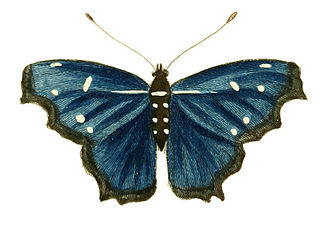
Myscelia orsis is a species of nymphalid butterflies native to Brazil. It was first described by Dru Drury in 1782.
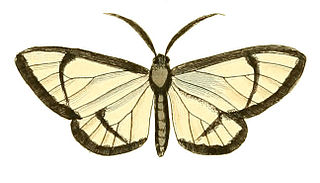
Locha hyalina is a moth species in the family Geometridae from Central and parts of South America. It was described by Dru Drury in 1782, but his name Phalaena diaphana was invalid as pre-occupied.

Zamarada eucharis is a species of moth in the family Geometridae. It was first described by Dru Drury in 1782, from Sierra Leone. It is found in Ivory Coast, Ghana, Guinea, Liberia and Sierra Leone
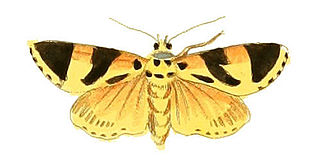
Attatha ino is a species of moth of the family Noctuidae. It was described by Dru Drury in 1782 from "Madras".
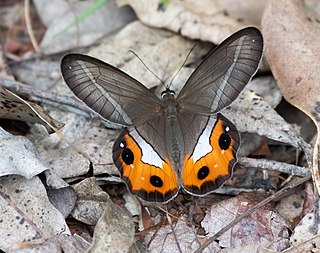
Pierella nereis is a butterfly species from the subfamily Satyrinae in the family Nymphalidae. It was first described by Dru Drury in 1782 from Brazil.

Heliconius sapho, the Sapho longwing, is a butterfly of the family Nymphalidae. It was described by Dru Drury in 1782. It is found from Mexico southward to Ecuador.



















